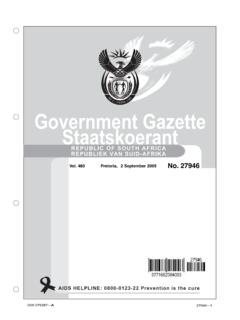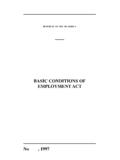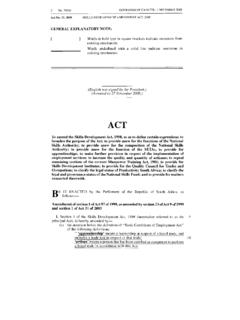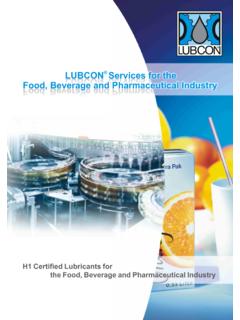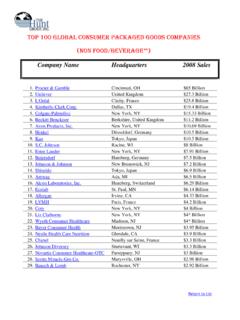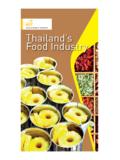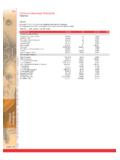Transcription of Health and Safety in the Food and Beverage Industry
1 Health and Safety in the food and Beverage IndustryWorkersinthisindustryareexposedt oawiderangeofhazardswhichincludethefollo wing: Samelevelfallswhichareoftencausedbyslipp eryconditionscanresultinsprainsandstrain s Exposuretosharpinstrumentssuchasknives Collisionwithinternaltransportsuchasfork liftsandcontainers Lifting, ,aswellaspoorworkposturewhichisoftenresu ltingfrominadequateworkspaceandpoordesig noftheprocessflow Exposuretonoise Exposuretochemicalhazards-exposuremaybef romchemicalhandlingactivitieswhichmayinc ludecleaningoperationsanddisinfectionofp rocessareas , :storagetanksandbins,pitsandsumps,fuelta nks,grapepressesandcrushers, level fall hazards, use of knives, collision, lifting andrepetitive work Maintainwalkwaysandworkingsurfacestobecl eananddrybypreventingspillagesduringoper ationandalsoprovidingworkerswithanti-sli pfootwear22 Provide workers with gloves that will protect them from knife cuts Reduce opportunities for collision when laying out process flowactivities Dermacate transport passages and working areas.
2 Also ensureplacement of handrails on platforms and stairs Prevent spillage of water/liquids Workers must be trained in proper lifting techniques and workstationsshould be designed to ensure that the worker has to noise Some operations suchas the canning,bottling, and the use ofconveyors causeworkers to be exposedto excessive noiselevels. Engineeringcontrol measuresshould be used toreduce the noiselevels, and personalprotection should hazardsThe following may controlexposure to biologicalhazards in this Industry : Install exhaustventilation at the thesource to reduce dust Provide workers withsuitable personal33 Workers in this Industry are exposed to a widerange of hazards including collision with internaltransport such as forklifts and equipment and ensure training on its proper use Promote personal hygiene and ensure physical segregation of workand welfare hazardsWorkers should be trained on safe working procedures for each activityinclusive of first aid and coldA registered medical practitioner or registered nurse must certify workersas medically spacesThe employer is responsible for determining if confined spaces arepresent in the workplace.
3 If there are any, all access points must besecured against entry or signs must be used to identify confined spaces. Work permits must be issued for work to be conducted in a confinedspace Workers must be provided with proper breathing apparatus prior toentering a confined space and they must be trained on how to use objects Ensure items stored above ground level ( on storage shelving) arestable and will not fall easily if disturbed. Store heavier items on ornear the ground and lighter items higher up Give careful consideration to methods of stacking, handling andmovement of goods to prevent articles falling Make sure tall self-standing objects ( gas cylinders) or objectsleaning against walls are stable if knocked, and secured. 44 Handtools Hand knives cause the greatest number of injuries and should besafely stored/sheathed when not in use When hand knives are in regular used, knife resistant protectiveclothing should be worn as determined by the risk assessment ( butchering an apron and forearm guard/glove for the non-knifehand) Hand tools should be maintained in good condition so that undueforce is not required to use them.
4 Moving objects Pedestrian operated pallet trucks, racks, trolleys etc. should usedesignated routes away from other workers where possible. Theperson pushing/pulling should have good visibility Risk assessment should consider which other work area specifichazards may be present ( rolling barrels or kegs, hoist hooks,items ejected from machines). food and drink manufactureThe food and drink manufacturing Industry actually comprises morethan 30 different industries. These range from slaughterhouses, sugarrefineries and grain mills to malt manufacture and whisky combined injury rate for food and drink industries is among thehighest. However injury rates vary considerably between the differentfood and drink industries. The main causes of injuries continue to be: manual handling/musculoskeletal injury slips on wet or food contaminated floors falls from heights workplace transport (including forklift transport) struck by something ( sharp knives or falling objects) 55 these, the main causes of fatal injury continue to be workplacetransport, including falls from heights and machinery.
5 Musculoskeletal injuries dermatitis noise occupational asthma rhinitis work related stress. Industries Meat and fish processing Milling, animal feeds Bakery products Dairy products 66 Workers should be trained on safe working procedures for each activityinclusive of first aid measures. Fruit and vegetables Confectionery Alcoholic and soft and frozen products The food production chain has three stages - farming, manufacturingand retailing/catering. food and drink manufacturing takes place infactories ranging in size from those employing only a few workers tothose employing hundreds. Indeed, many medium or larger sized foodand drink factories are themselves part of a national, or eveninternational, multi-site organisations, employing thousands of Department of Labour s field of responsibility primarily covers thefirst two stages in this chain farming and manufacturing . Retailing andcatering fall within the responsibility of local authority environmentalhealth departments, although the Department of Labour works withthese departments to ensure some consistency of approach on healthand Safety bbiigg ppiicct tuurreeOccupational Health is generally more difficult to manage than causes and consequences of poor Safety at work are immediateand often relatively easy to deal with.
6 Work-related causes of ill healthcan be more difficult to spot. It can often take some time for symptomsto develop so the connection between cause and effect is less obvious,but once the problems have been recognised and acknowledged,solutions are documented. For the most common occupational Health problems, such as backinjuries, there may be other causes that have nothing to do with may be unwilling to admit themselves that they havework-related Health problems because of fears about their job or thestigma attached to certain types of illness. For these reasons it is veryimportant to identify and reduce aggravating factors arising from work. 77 Despite the availabilty of information on solutions to work related healthproblems, local knowledge about the most effective solutions can belimited. Some of the larger businesses in the Industry employ specialistoccupational Health staff, usually with a medical background. However,for most businesses, especially small businesses, access to reliablemedical advice on occupational Health is very limited.
7 When most peoplehave a Health problem they visit their General Practitioner, but mostGeneral Practitioners are not well-qualified to deal with occupationalhealth businesses do not need to set up specialist departments or pay formedical advisors to control occupational Health on a day-to-day vast majority of occupational ill Health results from a small numberof basic causes, all of which can be controlled by management andworkers working together to identify practical control measures that aresuitable for their workplace. However, use of occupational physiciansand other experts can be cost effective in appropriate circumstances. This section explains the common causes of occupational ill Health in thefood and drink industries and provides advice on how to manage causesThe main causes of occupational ill Health in the food and drinkindustries are: musculoskeletal disorders (MSDs):mainly comprising work-relatedupper limb disorders (WRULDs) and back injuries work-related stress:which can be caused by poor work organisation occupational asthma:caused by inhalation of bakery and graindusts occupational dermatitis:from handwashing, contact with foodstuffs,etc.
8 Rhinitis:caused by irritant dusts such as bakery and grain dusts,spices and seasonings noise-induced hearing loss: where noise levels exceed 85 dB(A).88Of the above risks, MSDs(both WRULDs and backinjuries) are by far the mostcommon. However otherrisks are significant andapply where causes ofmusculoskeletal injuryIn the food and drinkindustries, mostmusculoskeletal injuriesarise from just five causes: stacking/unstackingcontainers (such asboxes, crates and sacks) pushing wheeled racks(such as oven racks andtrolleys of produce) cutting, boning, jointing,trussing and evisceration(such as meat andpoultry) packing products (suchas cheese, confectioneryand biscuits) handling drinks containers (such as delivery of casks, kegs andcrates) These are key tasks to which attention should be paid when carryingout risk do we know if we have a problem?Injury and Health problems show up in different ways, such as:99 Provide workers with gloves that will protect themfrom knife cuts.
9 Cases of injury to backs and limbs aches and pains poor product quality high material waste low output frequent worker complaints and rest stops do-it-yourself improvements to work stations and tools ( seatpadding) workers wearing bandages, splints, rub-ons, copper bracelets ormagnets. If you have a problem it will be costing money from sickness absence,high staff turnover, retraining, loss of production, etc. Compensationcases are increasing and problems may affect your asthmaData sources record a significant level of asthma in food and drinkmanufacturing. The main causes of asthma are inhalation of dust fromgrain and flour, with bakers having the second highest incidence rate ofall occupations in any of occupational asthmaWork-related asthma affects workers inhaling dust which is respiratorysensitisers - such as dust from grain, flour, enzyme additives, eggprotein, fish protein, spices and wood - so workers involved in milling,malting, baking, fish processing, etc.
10 Are at particular risk. Asthma is anextremely distressing and potentially a life-threatening dermatitisData sources record a significant level of of occupational dermatitisOccupational dermatitis affects workers handling meat, fish, poultry, fruitand vegetables, as well as bakers, confectioners, cooks, cleaners andmany other workers. In food preparation, it usually affects the hands and forearms It results in redness, scaling and blistering of the skin, oftensufficiently badly to keep people off work and serious enough to forcethem to change jobs Occupational dermatitis is caused by contact with water, soaps anddetergents (55% of cases) and contact with a wide variety of foodsuch as sugar, flour/dough, citrus fruits, vegetables, spices andherbs, fish and seafoods, meat and poultry (40% of cases).RhinitisRhinitis (runny or stuffy nose) results in inflammation of the nasalmucous membrane caused by irritant of rhinitisGrain, flour, spices, seasonings and wood dust can cause rhinitis,conjunctivitis (watery or prickly eyes) and other irritant hearing of noise-induced hearing lossExposure to high levels of noise at work can cause irreversible hearingdamage, which can be difficult to detect as the effects build up graduallyover time.

